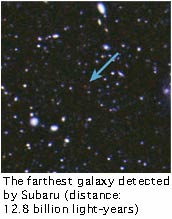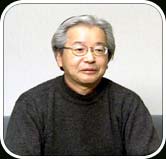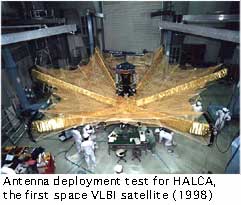 |
 |
 |
 |


File size : 13.6MB
Format : MPEG |
|
Q. What is the greatest achievement of the Subaru radio telescope?
I think its real achievements are yet to come, but will in the near future. That is because it’s been only three years since the Subaru’s first actual use for research, and it’s just recently that its various components have reached 100% performance. In a way, this kind of machine is never complete. There are a lot of complicated components, and we have to learn to make good use of them for better performance. The harder we work to improve, the better performance we can get. So, we are constantly challenging. Meanwhile, of course, there are other telescopes being developed as well, and competitors stimulate each other. That enables us to make new observations all the time.
Actually, there are no other 8-meter telescopes in the world as complicated and accurate as the Subaru. Moreover, it has various observational functions. Today, there are nine 8-meter-aperture telescopes in the world: four in Europe, four in the U.S. and one in Japan. Since in Japan we have only one, we have added various functions to it. For instance, one of the most important tasks of a telescope is to take clear images, and the Subaru, I’m proud to say, has the highest performance in this regard. Astronomical observers from around the world visit Subaru, and they’re always amazed by its high quality in comparison with other telescopes. So for now, I’ll put performance quality as the No.1 achievement of the Subaru.
 Among many observations made so far, I’d say the most remarkable achievement is the discovery of celestial bodies at very great distances. The Subaru is actually the record holder in celestial discovery. It has found nine of today’s 10 farthest bodies. This success is due to the high quality of image it can achieve. Among many observations made so far, I’d say the most remarkable achievement is the discovery of celestial bodies at very great distances. The Subaru is actually the record holder in celestial discovery. It has found nine of today’s 10 farthest bodies. This success is due to the high quality of image it can achieve.
The reason we are so keen to see celestial bodies at such great distance is that the farther a celestial body is from us, the closer it is to the beginning of the universe. For instance, it is said that it’s been about 13.7 billion years since the expansion of the universe began. The farthest galaxy the Subaru has found (each galaxy is a gathering of 100 billion fixed stars) is 12.8 billion light-years away. That means it’s taken 12.8 billion years for the light from that galaxy to reach us, so we’re seeing the galaxy as it was 12.8 billion years ago. That’s 900 million years after the expansion of the universe began. Supposing our galaxy, which is 13.7 billion years old, is represented as a person who is 50 years old. A galaxy at 900 million years would only be a 3-year-old child. So we can say that the Subaru is getting closer and closer to the origin of the universe, when expansion first began. The Subaru is surely a world-leading telescope. Due to this success, news of its various observations, from phenomena of our solar system to galaxies at great distances, are being reported every month.
|


File size : 17MB
Format : MPEG |
|
Q. NAOJ has had projects with the former Institute of Space and Astronautical Science, the Ministry of Education, Culture, Sports, Science and Technology (ISAS, currently a part of the Japan Aerospace Exploration Agency - JAXA). Tell us about any memorable events or great achievements.
Among all the collaborations with ISAS, the observation of the Sun has the longest history. The first satellite to observe the Sun with X-rays, HINOTORI (ASTRO-A), was launched by the Sun researcher of the then - Tokyo Astronomical Observatory, Prof. Katsuo Tanaka, working with a research team from ISAS. ISAS is famous for X-ray observation, and the NAOJ is known for its research on the Sun. So the collaboration was quite successful.
 Later, we again succeeded in gaining a lot of excellent data through the second-generation solar physics satellite YOHKOH (SOLAR-A). This project was carried out under Prof. Takeo Kosugi, who had transferred to ISAS from the astronomical observatory. His transfer completely succeeded in bonding the two organizations, and the observations became valuable to the world. Now, our third-generation satellite, SOLAR-B, is being prepared for launching. It is the first solar optical telescope in the world, and it is getting a lot of attention. Later, we again succeeded in gaining a lot of excellent data through the second-generation solar physics satellite YOHKOH (SOLAR-A). This project was carried out under Prof. Takeo Kosugi, who had transferred to ISAS from the astronomical observatory. His transfer completely succeeded in bonding the two organizations, and the observations became valuable to the world. Now, our third-generation satellite, SOLAR-B, is being prepared for launching. It is the first solar optical telescope in the world, and it is getting a lot of attention.
And also, since I specialize in radio astronomy, I vividly recall the first space VLBI satellite in the world, HALCA (MUSES-B). This was launched via the M-V-1 rocket, and its 8-meter parabolic antenna was expanded to its full size in space. It was an amazing success to learn how to do this, and to launch an instrument as large as an 8-meter-aperture radio telescope. It was such an adventure! Actually, this project was also conducted by Dr. Hisashi Hirabayashi who had transferred to ISAS from the Nobeyama Radio Observatory, where he had played a key role in developing VLBI (Very-Long Baseline Interferometry). Dr. Masaki Morimoto, who is my great elder colleague, was the originator of the project.
Many new trials have been done with HALCA. The current one is observation using a giant telescope, 20,000 kilometers in diameter, which is bigger than the Earth, made by connecting a radio telescope in orbit and a telescope on the ground. It is observing a lot of phenomena, like how particles releasing radio waves are emitted from a huge black hole in the middle of our galaxy. It is incredible that, despite the fact that HALCA is an engineering satellite designed for very complicated missions, it has a success rate of more than 85% in its tasks, including scientific observation. It’s unfortunate though, that recently the focus has been only on its failures, since Japan’s space science and technology have had world-class achievements. In my opinion, they deserve more fair attention.
|
|
 |

